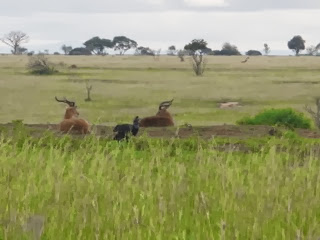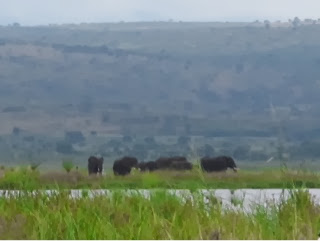I am a fabric tourist. I confess it freely. My problem has been going on for some time. Most of my fabric purchases have been in France. To give you some idea of the extent of my problem, I confess that I have purchased and brought home enough Provençal fabric to make four queen sized quilts for my children and fabric for curtains in three rooms. When I visited Martinique, I brought home enough to make one quilted throw, not to mention the stash still in a drawer. So when I started planning my trip to Africa, I began to dream about fabric.
The first step was to bring a partially empty suitcase. But beyond that was the quest, itself. Where would I find the fabric? What kinds of fabric would i find? Who could be my guide?
My guide in Kenya turned out to be my friend Anne’s mother. First she took me to the Masai Market. I began to see what was available and made my first purchases. The Masai wear a type of blanket, called the Shuka. The brightly colored Shuka falls loosely over their shoulders, and although the plaid designs seem improbable, on their supple forms, the Shuka seems just right. It is made of acrylic, and struck me as a wonderful, informal tablecloth.
The other fabric I bought at the market was a Khanga. This is a cotton print with an overall design, making it perfect for a loose duster. I don’t know if I’ll use it for that, but I love the black and cobalt print. The Khanga has a slogan. Each piece features a text in Kiswahil, almost like our T shirts with slogans and logos. The difference is that our T shirts reflect everything from a team name to profanity. The Khangas mostly had Christian sayings. The one I chose says, “ The Word of God is Eternal.”

The next day we visited Biashara Street in downtown Nairobi, which is where many fabric stores line the streets. After my previous experience at the market I was more prepared. One store was full of nothing but Khangas. But I already had mine. What I was looking for was Kikoys. The Kikoy is a type of scarf which is used sometimes like a wrap-around skirt, sometimes as a head covering, sometimes as a shawl. It is a soft, supple cotton, usually in pastels. The classic Kikoy has tassels, either knotted or beaded. The fabric itself is perfect for quilting or aprons, or even traditional shawls.
I bought my Kikoy fabric in a well stocked store, from skeptical gentlemen, who didn’t understand my selections, but who were more than willing to serve me.
My quest was not yet over, however. I had been given a length of wax print fabric, a year ago, by a Nigerian student. After a little research, I learned that wax printing is a type of batik, block printing, often done outside Africa, but favored within Africa for traditional clothing. As soon as I arrived in Kenya, I began to see women wearing traditional dresses made with this kind of fabric, known as Kitenge. And the more I saw, the more determined I was to come home with a piece of Kitenge fabric.
I looked in several stores, and found only a few Kintenge pieces, in colors and designs i didn’t particularly like. Finally I found a good selection at a place called Lucky Wear. The pieces were precut in 5.5 meter lengths. I felt very lucky.
After my success in Kenya, I was prepared to hold back in Uganda. I didn’t have free time to look for fabric, but I was fortunate. A friend gave me a piece of traditional Ugandan fabric, which is a heavy, closely woven cotton, in brilliant reds, yellows, black and violet. It is very different from the Kikoys I found in Kenya. Finally, in a restaurant where we ate on our way to the airport, I struck gold. There, on our last night in Africa, I found a 12 yard length of Kitenge fabric, that is the most beautiful of all.
I have not been cured from my fabric tourism. Now, it’s time to start making these pieces into quilts and clothes.



















































